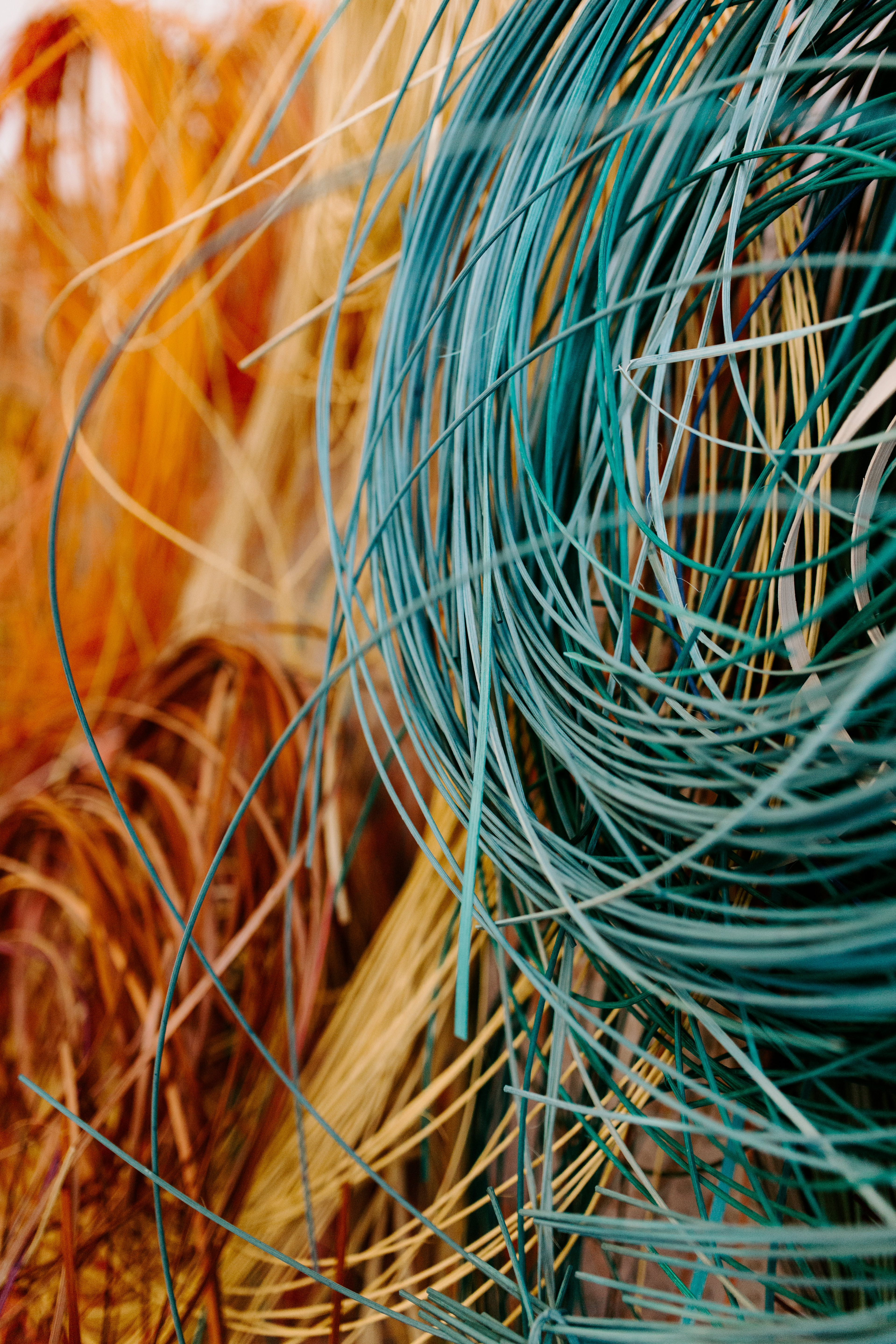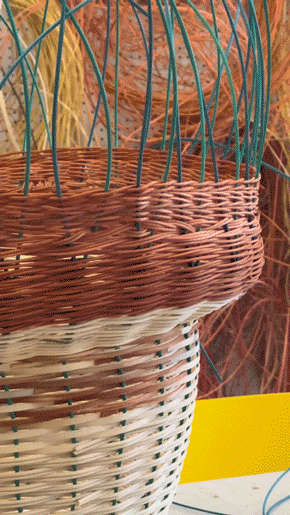Inspired by Artistry
︎︎︎ 04
Weaving color & story with Dee Clements
In a quiet workspace at the heart of Pilsen, Chicago, Dee Clements creates – a term used broadly to encapsulate the wide array of mediums and techniques she employs in her artistic process. Her design studio, Studio Herron, is tucked away in the massive, refurbished warehouse that is Mana Contemporary Chicago. Nestled among hundreds of other artists and makers, the white walls of her 500 square foot space are contrasted with the warm colors and textures of her works and materials: spools of natural reed spill onto the floor, bunches dyed in bright oranges, blues, and purples line the wall.
︎︎︎
Through decades of artistic experience, Dee’s initial focus on painting shifted to more tactile approaches like sculpture, fiber work, and textiles. Now she's inspired by working in the three-dimensional world, weaving with reed to create large-scale sculptural vessels, lighting, and dynamic pieces that interact with interior spaces on a more physical level.
Part of what drives her desire for a more tactile art form is a deep respect for the hand-made.
Dee is inspired by the ancestral craft of basketry, and her work explores a return to human-made art, removed from the fast-paced and technologically-dependent culture we find ourselves in today. In this, she’s reestablished a connection to the artists and craftspeople of our ancestors, a thread of making and creativity tying her modern art to thousands of years ago.
“As of now, there is not a machine that exists that can weave baskets. It’s always done by hand,” Dee told us. “We are in the geologic epoch called the Anthropocene, which signifies man’s domination over nature. In this current time, we are hyper-connected, glued to screens, and over-consume goods and products to the detriment of our planet. It’s good to tap back into the lizard brain and make things by hand.”
Dee’s work is layered, captivating, and completely derived from her self. The focal point of her current projects are woven, plant-based reed materials, but many of her pieces include additional elements that piqued our interest and curiosity. At the base of her larger works are hand-thrown ceramics, designed with small holes around the edge that become entry points for the reed. The reed itself is either of natural color or hand-dyed by Dee using colors she mixes in her studio (her test swatches and color palettes in earthy blues, browns, and greens line one wall). In other cases, she paints the reed directly, adding bits of color after the piece has already taken its final form. Dee shifts and shapes each piece while the reed is wet and malleable, resulting in asymmetrical woven vessels that expand through physical space with interesting lines and depth.
Learning about Dee’s process is both refreshing and encouraging. She’s an artist willing to allow herself the space to create from a place of abundance and care. She describes her work as intuitive, preferring to work alone in her “cocoon” of a studio. It’s a space she loves dearly, where her creativity feels untamed, and she’s safe to work through creative problems. Her studio is a place of introspection, and one she doesn’t invite visitors into often – making us feel all the luckier to have been welcomed in.
Holding this protected space for her work has resulted in impactful pieces that elevate interior spaces with their multi-dimensional, layered presence. At The Marina Grand Resort in New Buffalo, Michigan, Curioso collaborated with Dee to design and create cotton tapestries that bring fresh life to every guest room – each piece lovingly stitched together by hand in the studio we visit now.
![]()
![]()
︎︎︎
Through decades of artistic experience, Dee’s initial focus on painting shifted to more tactile approaches like sculpture, fiber work, and textiles. Now she's inspired by working in the three-dimensional world, weaving with reed to create large-scale sculptural vessels, lighting, and dynamic pieces that interact with interior spaces on a more physical level.
Part of what drives her desire for a more tactile art form is a deep respect for the hand-made.
Dee is inspired by the ancestral craft of basketry, and her work explores a return to human-made art, removed from the fast-paced and technologically-dependent culture we find ourselves in today. In this, she’s reestablished a connection to the artists and craftspeople of our ancestors, a thread of making and creativity tying her modern art to thousands of years ago.
“As of now, there is not a machine that exists that can weave baskets. It’s always done by hand,” Dee told us. “We are in the geologic epoch called the Anthropocene, which signifies man’s domination over nature. In this current time, we are hyper-connected, glued to screens, and over-consume goods and products to the detriment of our planet. It’s good to tap back into the lizard brain and make things by hand.”
Dee’s work is layered, captivating, and completely derived from her self. The focal point of her current projects are woven, plant-based reed materials, but many of her pieces include additional elements that piqued our interest and curiosity. At the base of her larger works are hand-thrown ceramics, designed with small holes around the edge that become entry points for the reed. The reed itself is either of natural color or hand-dyed by Dee using colors she mixes in her studio (her test swatches and color palettes in earthy blues, browns, and greens line one wall). In other cases, she paints the reed directly, adding bits of color after the piece has already taken its final form. Dee shifts and shapes each piece while the reed is wet and malleable, resulting in asymmetrical woven vessels that expand through physical space with interesting lines and depth.
Learning about Dee’s process is both refreshing and encouraging. She’s an artist willing to allow herself the space to create from a place of abundance and care. She describes her work as intuitive, preferring to work alone in her “cocoon” of a studio. It’s a space she loves dearly, where her creativity feels untamed, and she’s safe to work through creative problems. Her studio is a place of introspection, and one she doesn’t invite visitors into often – making us feel all the luckier to have been welcomed in.
Holding this protected space for her work has resulted in impactful pieces that elevate interior spaces with their multi-dimensional, layered presence. At The Marina Grand Resort in New Buffalo, Michigan, Curioso collaborated with Dee to design and create cotton tapestries that bring fresh life to every guest room – each piece lovingly stitched together by hand in the studio we visit now.




